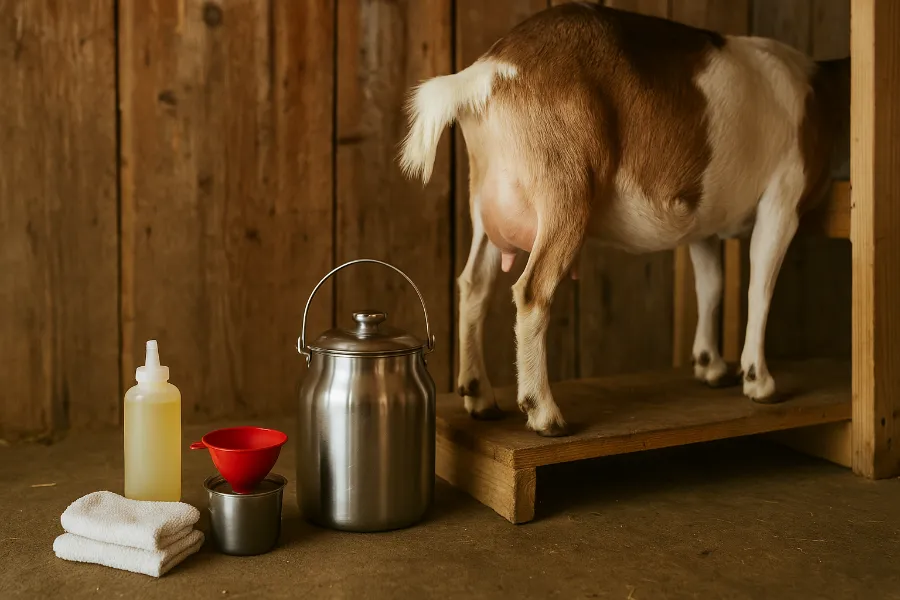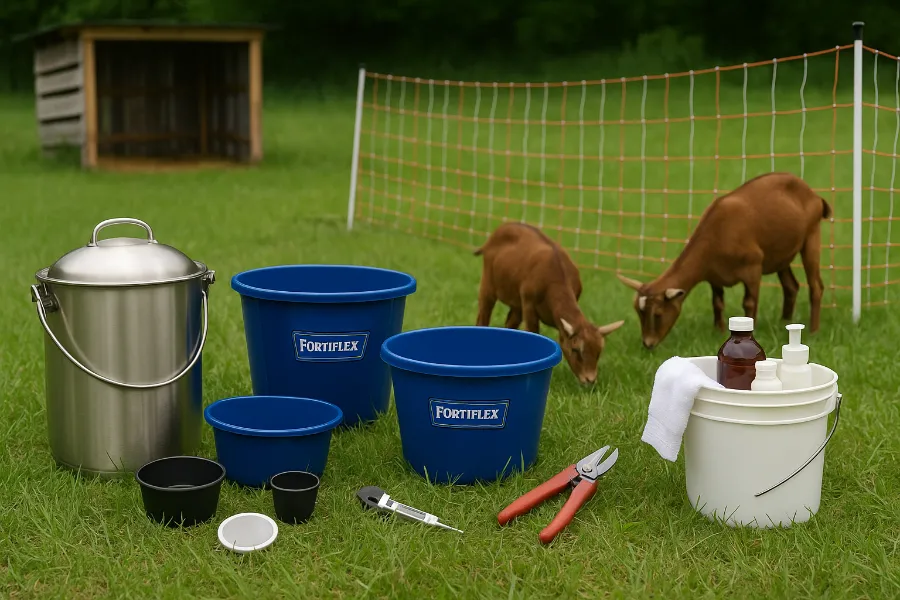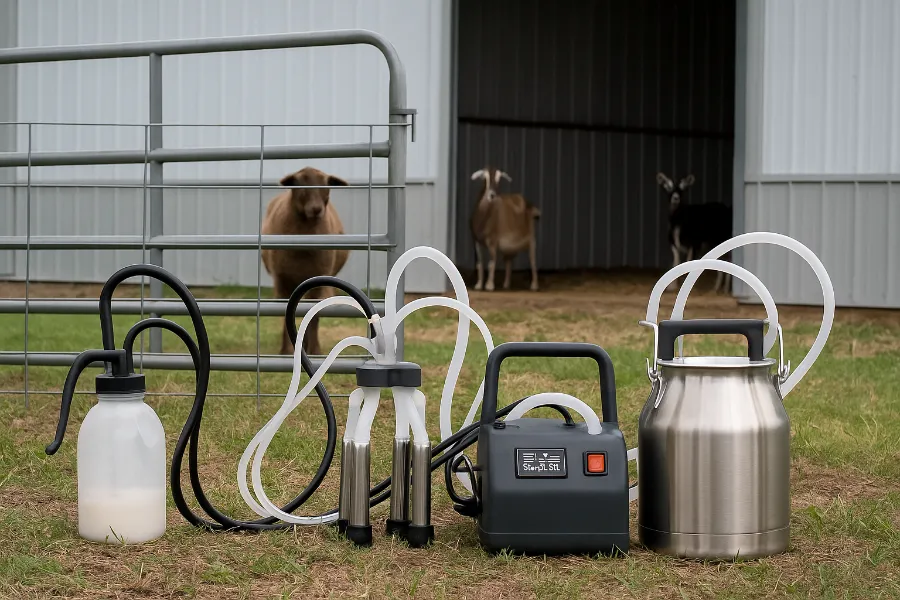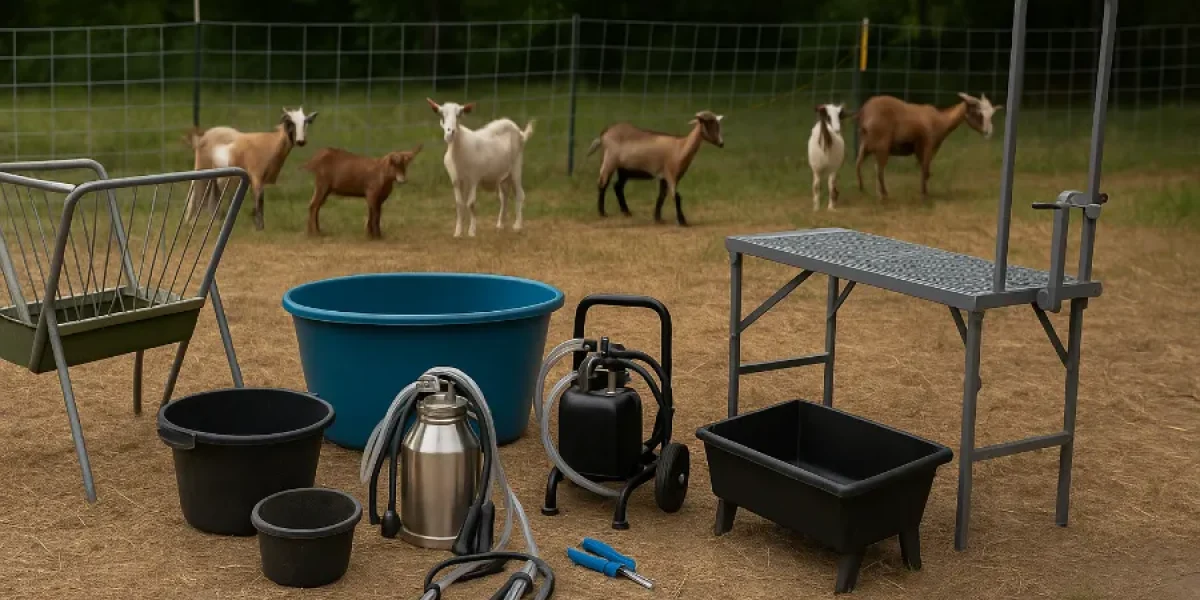When I first brought home my first dairy doe, I had no idea “goat milking machine” would become one of my most searched phrases. I was determined to do this right, and I wanted gear that would let me scale as I learned so I dove into goat farming equipment for beginners. Over time, I’ve tried everything from a humble stainless steel pail to a Wi-Fi-enabled automatic milker, and I want to share that journey with you.
In this post I’ll walk you through all the equipment I use (or have used) from the cheapest, most manual tools to the high-tech systems I only dreamed of at first. You’ll see what I’d buy today as a beginner, and what I’d upgrade later. Let’s get into it.

Goat Milking Equipment From Hands to Automation
You can milk a goat with nothing more than your hands and a bucket. That’s exactly how I started. But as your herd grows, that’s when a goat milking machine or better equipment makes a huge difference.
Manual / Traditional Setup
- Stainless steel milking pail — I bought mine from Hoegger Supply Co.; stainless steel is easier to sterilize than plastic (and helps avoid “off” flavors).
- Strip cup or small dip cup — I use a small black cup so I can inspect the first few squirts of milk (looking for blood, clumps, or signs of mastitis).
- Filter or strainer — when I was just doing one or two does, I’d use a canning funnel and reusable coffee filter. Later, I swapped to a milking filter disc from Hamby or Hoegger.
- Udder wash supplies — simple wash, mild soap, warm water, towels, and teat dip.
This setup might cost under $100 total. It’s slow, but it works well and teaches you respect for cleanliness and routine.
Mid-Range / Electric Milking Machine
Once I added a few more does, my back and wrists started protesting. I stepped up to a milking machine:
- Simple Pulse Milking System solid balance of price and performance. Electric suction, adjustable settings, easier cleaning.
- Dansha Farms hand vacuum milker a nice in-between for mobile use or when power’s spotty.
These let me milk faster, cleaner, and with less fatigue.
Modern / Smart Goat Milking Machine
Now I’m dreaming bigger (or already there, for the ambitious). With a smart system:
- Mitty Supply 2-Goat System fully stainless, automatic shutoff, better hygiene controls.
- GoatSmart Milking Automation Wi-Fi tracking, data on yield and udder health, integrated with herd software.
These are pricey ($1,500–$3,000+), but if your farm is growing or you value data automation, it’s worth considering someday.

Goat Feeders Minimizing Waste, Maximizing Efficiency
Feeding goats seems easy until you see them scatter hay everywhere or trample their grain. Having good goat feeders made a visible difference on my farm.
Budget & Traditional Feeders
- Fortiflex rubber feed tubs — tough, cheap, and flexible.
- DIY PVC feeders — I built cheap troughs with PVC and scrap wood in my early days.
Mid-Range Feeders
- Tarter wall-mount feeders — steel, durable, easy to attach in a barn.
- Behlen galvanized troughs — rust-resistant and reliable.
Modern Feeders
- Little Giant automatic feeders — gravity-fed, reliable, less manual refilling.
- Nero smart feed system — tracks feed consumption, portion control, digital logs (especially useful in dairy herds).
With better feeders, I cut feed waste noticeably, and goats were cleaner.
Goat Supplies — The Small Stuff That Holds It All Together
When I look back, all the little supplies are what saved me on tough days. Here’s what every beginner should have in their goat supplies stash:
- Buckets, brushes, mixing tubs
- Electrolytes and probiotics
- Dewormers, syringe guns, dosing equipment
- Digital thermometer
- Towels, iodine, birthing supplies
- First-aid ointments, sutures, etc.
These may seem boring, but almost every vet visit or sick goat comes down to having (or not having) the right supplies on hand.

Goat Hoof Trimmers — Keeping Feet Healthy
One of the first lessons I learned: poor hoof care will bite you down the road. Every goat needs trimmed hooves regularly, especially in humid or varied terrain.
Manual / Budget Trimmers
- Zenport or ARS hoof trimmers — sharp, robust, under $30.
- Hoof file or stone — to smooth rough edges.
Mid-Range & Electric Tools
- Caprine Supply deluxe kits — bundles with trimmers, shears, gloves.
- Andis clippers (corded or cordless) — useful for grooming or show goats.
Smart / Monitoring Tools
- ThermoChip health monitor — wireless temperature tracking.
- RFID / digital tagging (Shearwell) — helps monitor hoof health trends over time.
Trimming with confidence means healthier, more comfortable goats who are easier to handle.
Goat Housing Ideas — Shelter that Works, from Lean-tos to Smart Barns
Good housing keeps goats safe and comfortable. I had to rebuild mine more times than I’d like to admit before getting it right.
Traditional / Low-Cost Housing
- Pallet sheds or 3-sided lean-tos — cheap, functional.
- Fabric shelters from brands like ShelterLogic — good for conversions.
Mid-Range Barns & Kits
- Little Cottage Company barn kits — wood barns you can expand.
- Tarter metal barns — durable, simpler to maintain.
Smart & High-Tech Housing
- GoatSmart EcoShelter — climate-controlled, modular, sensor-monitored.
- Barn ventilation with solar fans, humidity sensors, etc.
My best advice: start simple but plan to expand. Make your shelter modular so you can build on it later.
Premier 1 Fencing — Portable, Practical, & Beginner-Friendly
When I decided to rotate pastures, Premier 1 fencing became a favorite. Their electric netting is portable, easy to set up, and safe for goats. It gave me flexibility to test paddocks and adapt as my layout changed.
Gallagher Electric Fence — Smart Perimeter Protection
For a permanent setup, I upgraded to Gallagher electric fence. Their systems combine durability, solar power, and, if you go for smart versions, remote monitoring. It’s more expensive, but the security and peace of mind are worth it.
Goat Farming Equipment — My Complete Checklist (Cheap to Expensive)
Here’s how I’d rank gear by investment, from what I’d buy first (on a shoestring) to what I’d buy as I grew:
| Equipment | Basic/Traditional | Mid-Range | Smart / High-Tech |
|---|---|---|---|
| Milking | Pail + dip + filter | Simple Pulse milker | GoatSmart automatic milker |
| Feeders | Rubber tubs, DIY troughs | Tarter feeders, Behlen troughs | Nero smart feeder |
| Housing | Pallet shed, fabric shelter | Kit barns, Tarter barns | EcoShelter with sensors |
| Fencing | Woven wire, T-posts | Premier 1 netting | Gallagher smart fence |
| Hoof care | Hand trimmers, file | Caprine kits, electric clippers | ThermoChip / RFID tracking |
| Supplies | Buckets, first aid kit | Full goat supply kits | Automated feeding/sanitizing systems |
When I started, I skipped everything I “didn’t think I needed” — and I regretted those choices later. Don’t under-prepare.
How I’d Build a Beginner Setup Today

If I were starting fresh right now, here’s my startup list (realistic, beginner-friendly):
- Stainless steel milking pail, filter, strip cup
- Fortiflex feed tubs and a bucket or two
- Zenport hoof trimmers and thermometer
- DIY 3-sided shelter + bedding
- Premier 1 electric net fencing
- Basic supply kit (drench, iodine, towels)
That gear would handle 2–5 goats easily. Then I’d gradually layer in upgrades — a Simple Pulse milker, Tarter feeders, a better barn, Gallagher fencing — as income or scale allows.
Final Thoughts (Personal Notes)
I still remember milking that first doe by hand in a leaky shed, and wondering if I had bitten off more than I could chew. But with the right goat farming equipment for beginners, that anxiety fades. Every tool you bring to your farm — whether a $10 hoof trimmer or a $2,000 milking machine — is really a way to buy time, health, and consistency.
If I were reading a blog like this when I was starting, I’d want someone who’s messed up, learned, and grown to walk me through what really matters. So I share this honestly I’ve broken buckets, upgraded fences, and changed milking systems more than once.
You don’t need every gadget on day one. But knowing where good tools fit in your journey helps you avoid regrets, wasted money, and frustration.
FAQs
Start with essentials like a sturdy fence, feeders, water buckets, hoof trimmers, and a reliable goat milking machine if you’re keeping dairy goats.
Beginner-friendly models like the Dansha Farms or Simple Pulse start around $200–$600, while automated systems can exceed $1,500.
Yes. Most modern machines have detachable parts and stainless-steel components that make cleaning fast and hygienic with warm water and sanitizer.
Rubber tubs and wall-mount steel feeders work best for small setups, while automatic feeders like Nero’s Smart Feed System help larger herds.
Portable Premier 1 fencing is ideal for new goat owners. For long-term setups, Gallagher electric fences offer better durability and solar options.
Every 4–6 weeks, depending on terrain and season. Regular trimming prevents infections, pain, and mobility issues.
Goats need a dry, draft-free shelter with good ventilation. Simple pallet sheds or prefab barns like Tarter’s work perfectly for beginners.













